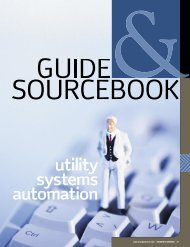asset management
asset management
asset management
You also want an ePaper? Increase the reach of your titles
YUMPU automatically turns print PDFs into web optimized ePapers that Google loves.
A D V EE RR TT II SS E M E N T<br />
TAKE BUDGET OUT OF PROJECTS,<br />
[ C A S E S T U D Y ]<br />
NOT PROJECTS OUT OF THE BUDGET<br />
The best way to balance all these disparate issues is by using a<br />
rigorous <strong>asset</strong> <strong>management</strong> approach to select the best matching<br />
set of programs and strategies, says KEMA’s Willis. “But the<br />
key point, based on the results I’ve seen, is that you can’t ignore<br />
equipment aging trends if you’re trying to do effective <strong>asset</strong> <strong>management</strong>.<br />
The two go hand in hand.”<br />
Zac Hager, Strategy and Total Quality Engineer with OG&E’s<br />
Asset Management team, notes that KEMA helped his team apply<br />
two other features that further improve <strong>asset</strong> <strong>management</strong>. “First, we<br />
think in terms of three budget areas, investment, maintenance, and<br />
operations, rather than two.” On KEMA’s advice, the traditional O&M<br />
area is viewed as two separate spending areas that buy different<br />
types of performance. Inspection and maintenance extend equipment<br />
lifetime and lower failure rate. Operations budget improves response<br />
and restoration to lessen the effects of escalating failure rates. “It can<br />
make better business sense to prepare and be able to react well,”<br />
he says, “than to try to lower breakdown rates. The key, always, is to<br />
balance and target spending and resources across those areas well.<br />
Second, OG&E’s <strong>asset</strong> <strong>management</strong> framework uses an optionbased<br />
approach which allows it create extra leverage as it balances<br />
activities and investment areas.”<br />
KEMA’s Willis notes that several utilities have reported rather<br />
disappointing results from <strong>asset</strong> <strong>management</strong>. “In every case they<br />
were using an <strong>asset</strong> <strong>management</strong> portfolio method to prioritize or<br />
optimize projects defined and scoped in the traditional manner.<br />
That just doesn’t work. If the traditional project paradigm goes<br />
in, traditional results come out. You have to set up a system that<br />
will take budget out of projects, not projects out of the budget.”<br />
The secret is creating a set of flexible, performance-based project<br />
options guidelines to replace the traditional engineering standards<br />
approach to the assessment of needs and specification of project<br />
design. “There are always several ways to do any project,”<br />
Willis adds, each with different costs and different results. Halfmeasures<br />
sometimes deliver far more than half results, and are<br />
a preferred approach. Other times ‘gold-plating’ will be justified<br />
based on what it brings. “The key is to let the portfolio optimization<br />
see those options, their cost and results differences, and make the<br />
decision about how to best balance all options from all considerations.”<br />
Do that, Willis says, and the utility will get the big impacts<br />
its upper <strong>management</strong> is expecting.<br />
Doug Patterson, Senior Planner at OG&E, and project manager<br />
for the effort, reports that a third of the project involved<br />
determining how to construct project and program options objectively,<br />
comprehensively, and efficiently. “Absolutely nothing can be<br />
untouchable when it comes to cost reduction. Remember, if you’re<br />
taking money from one place it’s because you want spend it where<br />
it will provide more value. It’s all to make the greatest contribution<br />
to overall company business goals.”<br />
OG&E also uses its portfolio optimization to select the penetration<br />
of maintenance and technology programs. “A big part<br />
of our planned performance improvement is based on what you<br />
might call optimized cherry picking,” Patterson adds. “We don’t<br />
have to inspect all breakers if we can target the ones that need<br />
service. Some feeder line switches produce six times the ‘bang’<br />
when you automate them compared to others.” Patterson’s team<br />
entered such programs in targeted 10 percent increments and let<br />
the optimization determine penetration and timing.<br />
“The key is to let the<br />
portfolio optimization<br />
see those options, their<br />
cost and results<br />
differences, and make<br />
the decision about how to<br />
best balance all options<br />
from all considerations.”<br />
GOOD RESULTS<br />
“This project has gone a long way toward helping OG&E prepare<br />
for the future,” OG&E’s Henry reports. The biggest impact may not<br />
be the technical, but rather the institutional and team understanding<br />
OG&E gained. “This project helps us take a business basis<br />
in our decision-making and focus on coordinating our activities<br />
so all decisions are coherent.” And OG&E gained a firm handle<br />
on system aging and how to manage for the inevitable results of<br />
wear and tear on its system. “We better understand what we face.<br />
We know what we know and what we don’t know, along with the<br />
priorities we should put on improving areas of our knowledge base<br />
and our system. Most important, we have a good roadmap for the<br />
future, for both IT and process improvements, and for how to invest<br />
and manage our T&D system going forward.”<br />
www.energybizmag.com ENERGYBIZ MAGAZINE 61



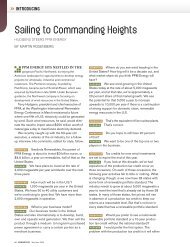

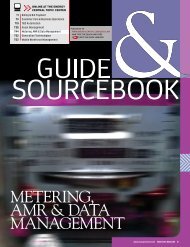

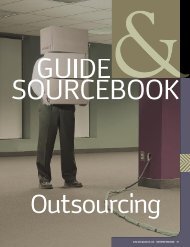




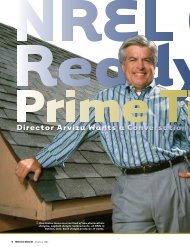
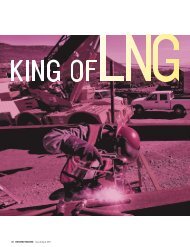


![View From the Trenches [PDF]](https://img.yumpu.com/18854438/1/190x252/view-from-the-trenches-pdf.jpg?quality=85)
